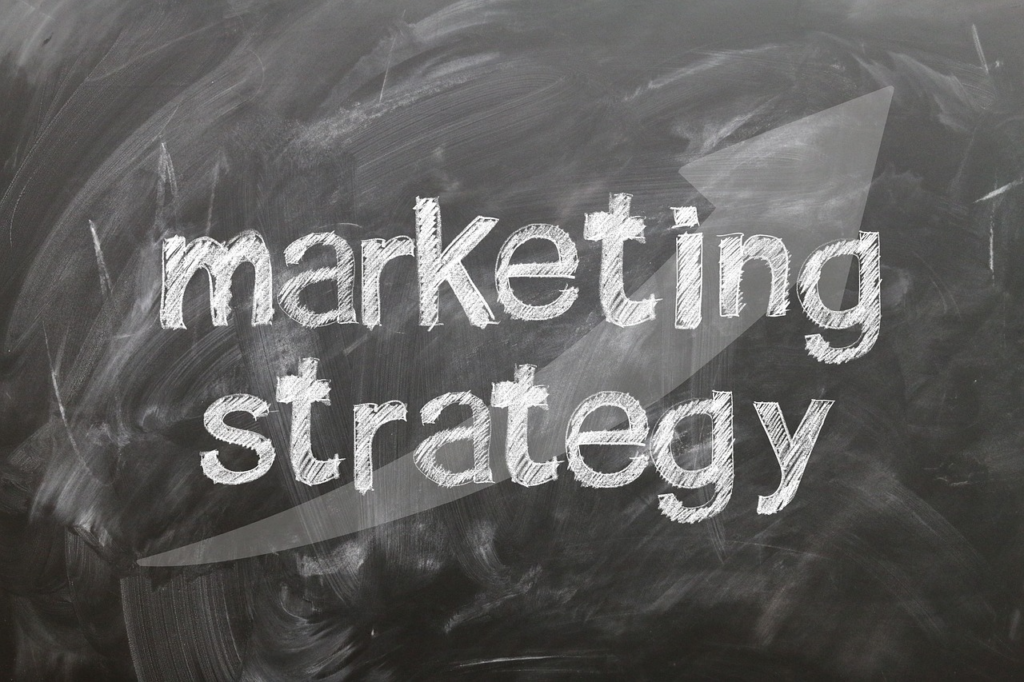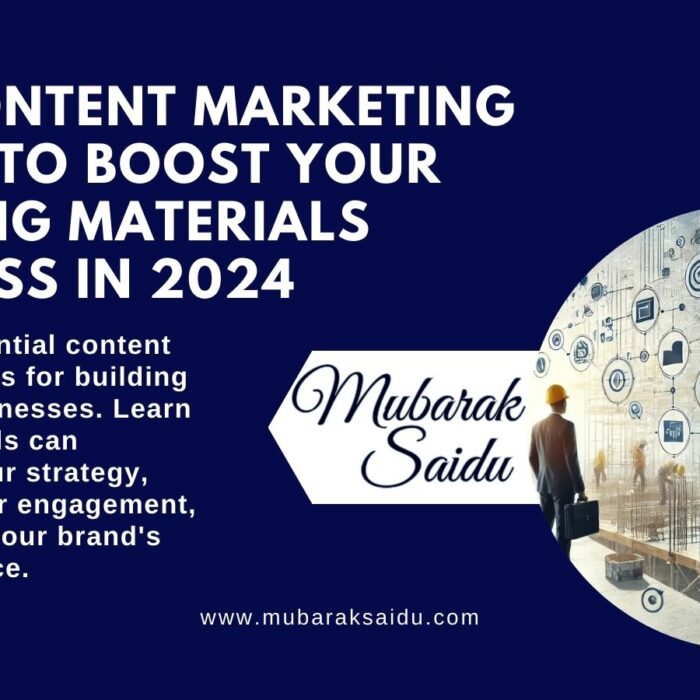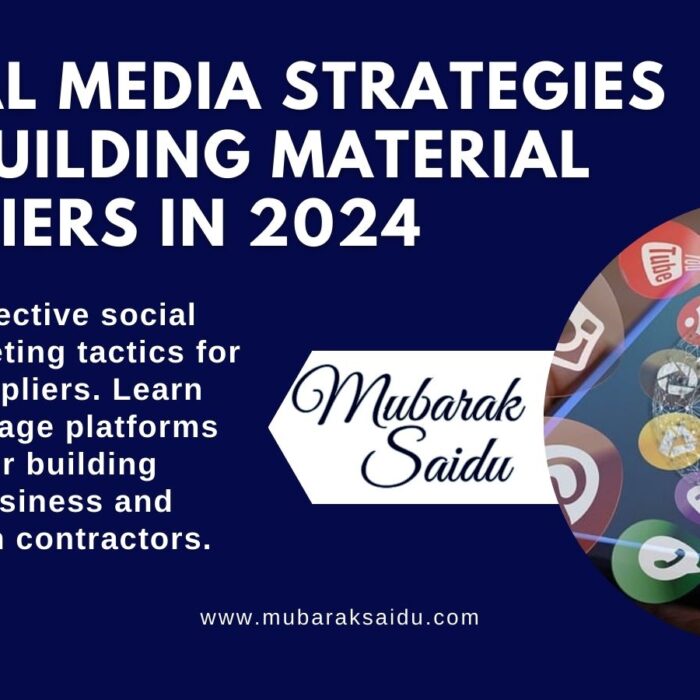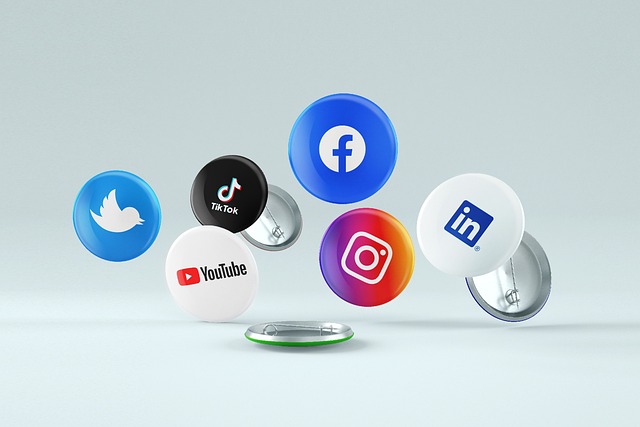
Did you know that the global building materials market is expected to reach a whopping $1.2 trillion by 2030? Wonderful! That’s a lot of bricks and mortar, folks! But here’s the kicker – with such massive growth comes fierce competition. As someone who’s been in the trenches of building materials marketing for about a decade, I can tell you that standing out in this crowded marketplace is tougher than nailing jelly to a wall.
Look, I get it. Marketing building materials isn’t exactly as sexy as selling the latest iPhone or Benz. But let me tell you, it’s just as crucial. Whether you’re selling to contractors, architects, or DIY enthusiasts, you need to step up your marketing game or risk becoming as obsolete as a wooden outhouse.
I remember when I first started in this industry, thinking that a few flyers and a sharing compliment card would do the trick. Oh! How wrong I was. I learned the hard way that effective marketing in the building materials sector requires a mix of traditional know-how and cutting-edge strategies.
But don’t worry, I’m not here to lecture you. Instead, I will share seven battle-tested strategies that’ll help you crush your marketing goals in 2024. These aren’t just theoretical mumbo-jumbo – they’re practical tips I’ve picked up from years of trial and error (emphasis on the error part).
So, grab your pen and pad, and let’s dive straight into these strategies!
Embrace Digital Transformation in Your Marketing Efforts
Alright, let’s kick things off with a big one – digital transformation. Now, I know what you’re thinking. “Digital transformation? In building materials? Isn’t that like putting lipstick on a pig?” Trust me, I used to think the same way. But I was so wrong!
Importance of Online Presence for Building Materials Suppliers
Listen up, folks. If you’re not online in 2024, you might as well be selling stone wheels to cavemen. I learned this the hard way when I lost a massive contract to a competitor simply because they had a slick website and we were still relying on print catalogs. Talk about a wake-up call!
Your online presence is like your digital storefront. It’s where contractors, architects, and homeowners go to check out your products, compare specs, and decide if you’re worth their time. And let me tell you, they’re judging you harder than Wizkid at a village music festival.
Key Digital Marketing Channels for Building Materials Industry
Now, don’t go thinking that slapping up a website is enough. Oh no, my friend. You’ve got to diversify your digital channels faster than an antelope escaping lion. Here are the big ones:
- Your website (duh!)
- Social media (more on this later)
- Email marketing (old school, but still kicking)
- Content marketing (blogs, videos, the works)
- Search engine optimization (because if Google can’t find you, neither can your customers)
I remember when we first started our company blog. I thought, “Who the heck wants to read about drywall?” Turns out, a lot of people! Our traffic shot up faster than a rocket on steroids.
Balancing Traditional and Digital Marketing Approaches
Now, before you go all-in on digital and toss your print materials in the trash, hang on. The key is balance. Think of it like a well-built house – you need a solid foundation (traditional marketing) and modern amenities (digital marketing).
I still swear by trade shows and face-to-face meetings. There’s something about shaking hands and seeing products in person that a website just can’t replicate. But I combine these with targeted online ads and email campaigns. It’s like having your cake and eating it too!
The bottom line? Embrace digital, but don’t abandon traditional methods that work. It’s all about finding the right mix for your business. And trust me, when you do, it’s like uncovering a pearl in an oyster.
Leverage Content Marketing to Showcase Your Expertise

Alright, buckle up your sleeves, ’cause we’re about to dive into the world of content marketing. Now, I know what you’re thinking – “Content marketing? Isn’t that just a fancy term for blogging?” Well, let me tell you, it’s so much more than that!
Types of Content That Resonate With Building Professionals
When I first started in this business, I thought content marketing was about as useful as a screen door on a submarine. Boy, was I was very wrong! It turns out, that building professionals are hungry for good content. They eat it up faster than a hyena eats up a carcass.
Here’s the deal: building professionals want content that makes their lives easier. They’re not looking for fluffy pieces about the “Top 10 Cutest Hammers” (although, now that I think about it, that might actually work). They want meat and potatoes content. Stuff like:
- How-to guides and tutorials
- Product comparisons
- Case studies of successful projects
- Industry trend analysis
- Regulatory updates and compliance guides
I remember when we published our first in-depth guide on energy-efficient insulation. I thought it would be about as popular as a root canal. But holy smokes, it went viral faster than a cat video! Turns out, contractors and architects were desperate for that kind of detailed, practical information.
Creating a Content Calendar for Consistent Engagement
Now, here’s where a lot of folks trip up. They create one piece of killer content, pat themselves on the back, and then… crickets. Nothing for months. That’s about as effective as a chocolate teapot, folks.
You need to be consistent with your content like a nagging spouse reminding you to take out the trash. That’s where a content calendar comes in handy. It’s like a roadmap for your content strategy.
I’ll let you in on a little secret – I use a simple spreadsheet to plan out our content. Nothing fancy, just dates, topics, and who’s responsible. It keeps us on track better than a bloodhound on a scent trail.
Pro tip: Mix up your content types. Don’t just stick to blog posts. Throw in some videos, infographics, and podcasts. Keep your audience on their toes!
Measuring The Impact Of Your Content Marketing Efforts
Now, don’t go thinking that just because you’re pumping out content like a chicken lays eggs, you’re doing a good job. You gotta measure that stuff! Otherwise, you’re just shooting in the dark, hoping to hit something.
When we first started measuring our content impact, it was like trying to nail jelly to a wall. We were looking at all sorts of metrics – page views, time on page, social shares. It was enough to make your head spin faster than a power drill.
Eventually, we figured out what really mattered:
- Lead generation: How many leads is your content bringing in?
- Engagement: Are people actually reading/watching/listening to your stuff?
- SEO impact: Is your content helping you climb the Google ladder?
- Sales influence: Is your content actually helping close deals?
I’ll never forget the day we traced a huge supply contract back to a blog post about sustainable roofing materials. That was the day I became a true content marketing believer!
Remember folks, content marketing isn’t just about creating stuff. It’s about creating the right stuff, consistently, and measuring its impact. Do that, and you’ll be laughing all the way to the bank!
Harness the Power of Social Media for Building Materials

Alright, let’s talk about Social Media. Now, I know what you’re thinking. “Social media? For building materials? Isn’t that like trying to make concrete sexy?” Well, let me tell you, my friend, if I can make insulation interesting on Instagram, you can do anything!
Identifying The Most Effective Social Platforms for Your Audience
First things first, you have figure out where your audience is hanging out online. It’s like finding the right joint to meet your homies – you don’t want to end up at a fruit stand when you’re actually looking for a butcher shop.
When I first dipped my toes into the social media waters, I made the rookie mistake of trying to be everywhere at once. Facebook, Twitter, Instagram, LinkedIn, heck, I even tried TikTok! (Let’s just say my “Concrete Mixing Dance” didn’t go viral.)
After a lot of trial and error (emphasis on the error), I figured out where our audience really was:
- LinkedIn: Great for reaching architects and commercial contractors
- Instagram: Perfect for showcasing beautiful finished projects
- YouTube: Ideal for how-to videos and product demonstrations
- Facebook: Good for reaching DIY homeowners
Remember, it’s better to do a bang-up job on one or two platforms than to spread yourself thinner than cheap paint.
Strategies for Engaging Content on Each Platform
Now, here’s where the rubber meets the road. You can’t just post a picture of cement and expect people to go wild. You gotta get creative!
On LinkedIn, we share industry insights, trend reports, and thought leadership pieces. It’s like a virtual networking event, minus the stale coffee and awkward small talk.
For Instagram, we go heavy on the visuals. Before and after project shots, time-lapse videos of installations, even the occasional meme.
YouTube is our go-to for tutorials and product demos. We once did a “Will It Waterproof?” series that was part MythBusters, part infomercial. It was a riot to film and our viewers loved it!
On Facebook, we focus on tips for homeowners and DIYers. Our “Weekend Warrior Wednesday” posts, featuring quick home improvement projects, always get a ton of engagement.
Using Social Media To Build Relationships With Industry Professionals
Here’s the kicker – social media isn’t just about broadcasting your message. It’s about building relationships. It’s like a virtual handshake but without the risk of a weak handshake.
I make it a point to regularly engage with our followers. I answer questions, offer advice, and even throw in the occasional dad joke (much to my team’s chagrin). This personal touch has led to some great connections and even a few big contracts.
We also use social media to showcase our partnerships and collaborations. When we worked on that eco-friendly estate in Abuja, you bet we were tagging the architects and contractors in our posts. It’s all about spreading the love (and the exposure).
And here’s a pro tip – don’t be afraid to show your human side. When our warehouse flooded last year, we posted about it on social media. The outpouring of support (and flood-related puns) from our community was overwhelming.
Remember, at the end of the day, even in the world of building materials, business is still about people. Use social media to connect, engage, and build relationships. Do that, and you’ll be laying a foundation for success stronger than reinforced concrete!
Optimize Your Website for Search Engines and User Experience

Alright, people, let’s talk about websites. Now, I know some of you might be thinking, “My website’s fine! I updated it back in 2015!” Well, let me tell you, if your website is older than your youngest kid, it’s time for a refresh. Trust me, I learned this lesson the hard way.
Key Elements of SEO for Building Materials Websites
SEO. Three little letters that stand for Search Engine Optimization can make or break your online presence. When I first heard about SEO, I thought it was some kind of fancy European car. Mehn, I was wrong! Search Engine Optimization is like the secret sauce of the internet. Get it right, and you’ll be swimming in leads. Get it wrong, and you’ll be lonelier than a fork in a world of soup.
Here are the key ingredients for a tasty SEO strategy:
- Keywords: Use relevant terms like “eco-friendly tiles” or “high-strength concrete mix”. But don’t go overboard – keyword stuffing is about as appealing as a concrete sandwich.
- Meta descriptions: These little snippets are like the movie trailer for your webpage. Make them snappy and include your keywords.
- Quality content: Google loves fresh, relevant content more than I love a cold drink after a long day on the job site.
- Mobile optimization: If your site isn’t mobile-friendly in 2024, you might as well be using a carrier pigeon to send messages.
- Page speed: A slow website is like a sloth in the 100-meter dash – it’s not gonna win any races.
Improving Site Navigation And User Experience
Now, let’s talk about user experience. Your website should be easier to navigate than a well-planned city, not a maze designed by a sadistic architect.
I remember visiting a competitor’s website once. It was like trying to navigate a maze with your eyes closed. Needless to say, I left faster than a lightning bolt. Don’t let that be your website!
Here’s how to make your site more user-friendly than a golden retriever:
- Clear menu structure: Organize your products and services logically. Think of it like arranging tools in a toolbox – everything should have its place.
- Search function: Add a search bar. It’s like giving your visitors a GPS for your website.
- Mobile responsiveness: Make sure your site looks good on phones and tablets. More people browse on mobile than on desktops these days.
- Fast loading times: If your site takes longer to load than it takes to mix a batch of concrete, you’ve got a problem.
- Clear calls-to-action: Make it obvious what you want visitors to do next. “Contact Us,” “Get a Quote,” you know the drill.
Incorporating Product Information And Specifications Effectively
Now, let’s talk about product info. This is where the rubber meets the road, folks. Your product pages should be more informative than a Wikipedia article and more attractive than a fresh coat of paint.
When we revamped our product pages, we saw our bounce rate drop faster than a lead balloon. Here’s what we did:
- Clear, high-quality images: Show your products from all angles. Heck, throw in a 360-degree view if you can.
- Detailed specifications: List all the nitty-gritty details. Dimensions, materials, load-bearing capacity – if it’s relevant, include it.
- Application examples: Show how your products are used in real-world scenarios. It’s like a ‘show and tell’ for grown-ups.
- Downloadable resources: Technical sheets, installation guides, BIM files – make them all available. It’s like giving away free samples, but digital.
- Customer reviews: Let your happy customers do the talking. It’s more convincing than a smooth-talking salesman.
Remember, your website is often the first impression a potential customer gets of your business. Make it count! A well-optimized, user-friendly site with comprehensive product information is like a well-built house – it’ll stand the test of time and keep your customers coming back for more.
Implement Targeted Email Marketing Campaigns

Alright, prepare yourself,, because we’re about to dive into the world of email marketing. Now, I know what you’re thinking. “Email marketing? Isn’t that as dead as disco?” Well, let me tell you, email marketing is alive and kicking harder than a mule with a sore tooth!
Building and Segmenting Your Email List
First things first, you need to build your email list. And no, I don’t mean buying some sketchy list off the internet. That’s about as effective as trying to nail Jell-O to a tree. You want real, engaged contacts who actually want to hear from you.
We started building our list by offering a free guide on “10 Mistakes to Avoid When Choosing Building Materials.” It was like throwing a steak into a pack of hungry dogs – people couldn’t sign up fast enough!
But here’s the kicker – you can’t treat all your contacts the same. That’s like using the same nail for every job. You’ve got to segment your list. Here’s how we do it:
- Contractors
- Architects
- DIY homeowners
- Distributors
- Commercial builders
Each group gets different content tailored to their needs. It’s like serving a personalized menu instead of a one-size-fits-all buffet.
Crafting Compelling Email Content For Different Audience Segments
Now, let’s talk about the meat and potatoes – the content of your emails. This is where the action starts.
For contractors, we focus on product specs, installation tips, and bulk pricing. It’s all about helping them get the job done faster and cheaper.
Architects get emails about innovative materials, case studies, and sustainability features. They eat that stuff up like it’s candy.
DIY homeowners? They love our weekend project ideas and “how-to” guides. We once sent out a guide on “5 Ways to Spruce Up Your Bathroom on a Budget” and our website traffic soared like a bird.
The key is to provide value. Don’t just sell, sell, sell. That’s as annoying as nails on a chalkboard. Instead, educate, inform, and inspire. Your sales will follow naturally.
Automating Email Workflows For Nurturing Leads
Now, here’s where the magic happens – automated email workflows. It’s like having a salesperson who works 24/7 without tea breaks or vacation time.
We set up a series of emails that go out automatically based on how someone interacts with our website or previous emails. It’s like a “Choose Your Own Adventure” book, but for building materials.
For example, if someone downloads our guide on eco-friendly insulation, they automatically get a series of emails about our green product line, case studies of successful installations, and eventually, a gentle nudge towards requesting a quote.
I remember when we first set this up, I was skeptical. It felt like we were being pushy. But you know what? Our leads started moving through the sales funnel faster than water through a broken pipe. And the best part? It all happened automatically, while we were busy with other things.
The bottom line is this: email marketing, when done right, can be your best salesperson. It’s persistent without being annoying, informative without being boring, and personal without being creepy. Master this, and you’ll have more leads than you know what to do with!
Showcase Your Products with Virtual and Augmented Reality

Alright, folks, strap on your VR goggles because we’re about to take a wild ride into the future of building materials marketing. I’m talking about Virtual Reality (VR) and Augmented Reality (AR). Now, I know what you’re thinking. “Isn’t that just for video games and those high-end tech firms?” Well, let me tell you, it’s revolutionizing our industry faster than you can say “3D-printed house”!
Benefits Of Vr And Ar In Building Materials Marketing
When I first heard about using VR and AR for marketing building materials, I thought it was crazier than trying to hammer a nail with a banana. But boy, was I wrong! The benefits are more numerous than the shades in a paint swatch book:
- Product Visualization: Customers can see how that new flooring or siding will look in their space before they buy. It’s like try-before-you-buy, but without the mess!
- Interactive Catalogs: Forget those dusty old product catalogs. With AR, customers can place virtual products in their real environment. It’s like Pokemon Go, but for building materials!
- Training and Education: We use VR to train contractors on proper installation techniques. It’s safer, cheaper, and less messy than hands-on training with actual materials.
- Enhanced Trade Show Experiences: Our VR booth at the last building expo was more popular than free beer at a frat party!
- Improved Customer Confidence: When customers can visualize the end result, they’re more likely to pull the trigger on a purchase. It’s like having a crystal ball, but way cooler.
Examples Of Successful Ar/Vr Implementations In The Industry
Now, I know what you’re thinking. “Sounds great, but does it actually work?” Well, let me tell you about a few success stories that’ll knock your hard hat off:
- Virtual Showroom: We created a VR showroom where customers can walk through and interact with our products. Our sales went up faster than an express elevator in a skyscraper!
- AR Product Placement App: We developed an app that lets customers place virtual versions of our products in their own homes. It was such a hit, we had trouble keeping up with demand!
- VR Safety Training: We use VR to train workers on safety procedures for handling hazardous materials. Accidents dropped quicker than a hot rivet!
- AR Installation Guide: Our AR app overlays installation instructions onto the actual product. It’s like having an expert looking over your shoulder, minus the coffee breath.
Getting Started With AR/VR On A Budget
Now, I know what you’re thinking. “Sounds great, but I bet it costs an arm and a leg!” Well, hold onto your wallet, because it’s more affordable than you might think.
When we first dipped our toes into the AR/VR waters, we started small:
- 360-degree product photos: We used a regular smartphone and a cheap rotating platform. Total cost? Less than a good power drill.
- Basic AR app: We found a freelance developer who created a simple AR app for product visualization. It wasn’t fancy, but it did the job.
- Google Cardboard: For our first VR experience, we used Google Cardboard viewers. They’re cheaper than a box of nails!
- YouTube 360: We created 360-degree videos of our products and uploaded them to YouTube. Free and effective!
Remember, you don’t need to go all-in right away. Start small, test the waters, and scale up as you see results. It’s like building a house – you start with the foundation and work your way up.
The bottom line is this: VR and AR aren’t just fancy gimmicks. They’re powerful tools that can give you an edge sharper than a new circular saw blade. Embrace them now, and you’ll be light-years ahead of the competition. Trust me, it’s more fun than a barrel of monkeys… and a lot more profitable!
Build Strategic Partnerships and Leverage Influencer Marketing

Alright people, we’re in the home stretch now. Let’s talk about something that’s more valuable than a contractor with his own lumber yard – strategic partnerships and influencer marketing. Now, I know what you’re thinking. “Influencers? Isn’t that just for makeup and energy drinks?” Well, hold onto your hard hats, because influencer marketing in the building materials world is hotter than a freshly welded steel beam!
Identifying Potential Partners In The Construction Industry
First things first, let’s talk about finding the right partners. It’s like finding the perfect nail for your project – you need the right fit, or things just won’t hold together.
When we first started looking for partners, we cast a net wider than a circus tent. We looked at:
- Complementary product manufacturers
- Construction software companies
- Trade associations
- Architecture firms
- Large construction companies
The key is to find partners who complement your offerings without directly competing. It’s like peanut butter and jelly – great on their own, but even better together!
I remember when we partnered with a leading construction project management software company. At first, I thought it was as useful as a screen door on a submarine. I couldn’t have been more wrong! Our products started popping up in their software recommendations, and our sales shot up faster than a helium balloon at a kid’s birthday party.
Collaborating With Influencers And Thought Leaders
Now, let’s talk influencers. And no, I don’t mean those Instagram models trying to sell you teeth whitening kits. I’m talking about the rockstars of the construction world!
We look for influencers like:
- Popular DIY YouTubers
- Well-known architects
- Respected contractors with a strong social media presence
- Industry bloggers and podcasters
When we first dipped our toes into influencer marketing, I was skeptical. I thought, “Who’s going to watch a video about drywall?” Well, slap me silly and call me Susan, because those videos took off like a rocket!
We collaborated with a popular home renovation YouTuber on a series about soundproofing. Not only did our products get featured, but we also got a ton of backlinks to our website. It was like hitting the SEO jackpot!
Measuring The Roi Of Partnership And Influencer Marketing Efforts
Now, here’s where the rubber meets the road. How do you know if all this partnering and influencing is actually working? It’s not like you can measure it with a tape measure!
When we first started, our idea of measuring ROI was about as accurate as eyeballing a cut on a 2×4. But we quickly learned to track things like:
- Referral traffic from partner websites
- Engagement rates on influencer content
- Increase in branded search terms
- Sales attributed to partner or influencer codes
We use good old Google Analytics, some fancy-pants social media tracking tools, and good old-fashioned “How did you hear about us?” questions.
I’ll never forget when we realized that a single collaboration with a well-known architect had brought in more leads in a month than our entire sales team had generated in the previous quarter. It was like striking oil in your backyard!
Remember, partnerships and influencer collaborations are like building a house – it takes time, effort, and a bit of trial and error. But when you get it right, you’ve built something that’ll stand the test of time (and bring you good fortune in the process).
So there you have it, folks. Strategic partnerships and influencer marketing might sound like buzzwords, but they’re as essential to modern marketing as a level is to a good foundation. Ignore them at your peril, or embrace them and watch your business grow faster than mold on a damp 2×4!
Conclusion
Well, folks, we’ve covered more ground than a cement truck on a busy day. From digital transformation to VR showrooms, we’ve explored seven strategies that’ll help you market your building materials like a pro in 2024.
Remember, marketing building materials isn’t just about showcasing your products. It’s about building relationships, providing value, and staying ahead of the curve. It’s like constructing a skyscraper – you need a solid foundation (your core products), the right tools (your marketing strategies), and a vision of the final result (your business goals).
Now, I know change can be scarier than walking a tightrope over a construction site. But trust me, implementing these strategies is easier than you think. Start small, test the waters, and before you know it, you’ll be swimming in leads and sales.
And hey, don’t be afraid to put your own spin on these strategies. Every business is unique, like a custom-built home. What works for one might not work for another. So experiment, analyze, and adjust. It’s all part of the process.
Remember, in the world of building materials, quality and reliability are key. The same goes for your marketing. Be consistent, be authentic, and always, always provide value to your customers.
So, what are you waiting for? Get out there and start building your marketing empire! And if you’ve got any tips or success stories of your own, don’t be shy – share them in the comments below. After all, we’re all in this together, like a well-oiled construction crew.
Now, if you’ll excuse me, I’ve got some virtual reality goggles to strap on and a social media post about the latest in eco-friendly insulation to write. This building materials marketing game waits for no one!



